GELID GX-7 CPU Cooler Review

This article is dedicated to GELID’s new flagship cooler. Let’s find out if this pretty expensive newcomer will be able to become a recognized air-cooling leader.
GELID Solutions Ltd. takes its time in designing and launching new cooling products. While other well-known companies launch about 2-3 new coolers every six months, GELID was for a while stuck with their pretty interesting Tranquillo cooler and just recently refreshed its revision by adding support of the new processor sockets. It could be that the company doesn’t have enough resources or is running out of new ideas and therefore can’t come up with another super-cooler just yet, or maybe GELID has been secretly focusing on a new super-cooler all this time getting ready to impress the users? In any case, two years after the launch of the first Tranquillo the company has finally introduced their new GELID GX-7 cooler. And judging by its recommended retail price of $70, we assume it is going to be pretty ambitious. Our today’s review will show if they prove justified or not.
Packaging and Accessories
The cooler comes in pretty standard packaging: a cardboard box of medium size with a plastic carry-handle:
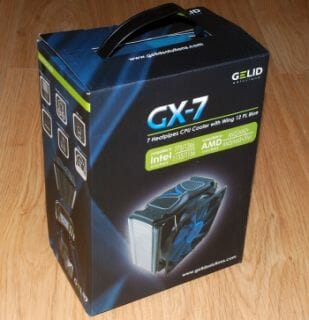
At the same time it is highly informative. The cooler photo on the front of the box is accompanied with a description of its key features, list of supported platforms and technical specifications on the back and sides:

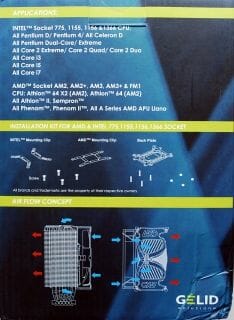

Inside the cardboard box there is a plastic casing with the heatsink and fan encapsulated inside. On top of them there is a small box with bundled accessories:

Among them we find everything necessary to successfully install GELID GX-7 onto any contemporary platform, a manual, four wire clips for attaching two fans and GELID GC-2 thermal paste. We were a little puzzled why they would include this thermal paste with the new cooler, because according to the information from the official company web-site, it has already been discontinued. And why wouldn’t they want to include the best GELID GC-EXTREME thermal paste with the top cooler? For some reason, they didn’t do it.
The new cooler is manufactured in China and comes with a three-year warranty. Its MZSRP is set at $70 or €45.
Design and Functionality
On the exterior, GELID GX-7 doesn’t really stand out that much. It looks like a pretty common tower-cooler measuring 159x130x65 mm and weighing 720 grams with one 120 mm fan:
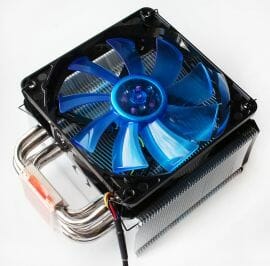
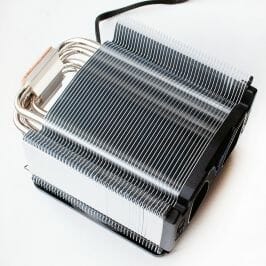
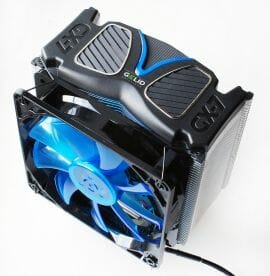
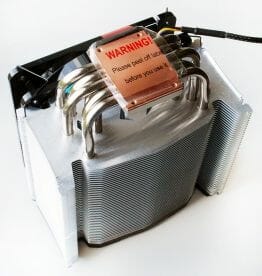
The heatsink consists of 45 aluminum fins, each 0.4 mm thick that are pressed against the heatpipes at 2.0 mm distance from one another. The calculated effective heatsink surface area is not that big and equals about 6400 cm2. There is a plastic panel with the company name and cooler model on it that covers the ends of the 6 mm heatpipes. The copper base surface is covered with a protective film warning the user that it needs to be removed before cooler installation.
The fins are bent downwards along the heatsink left and right sides, so that the air flow gets concentrated on the heatpipes and fins:
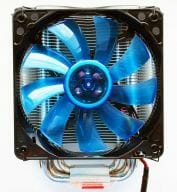
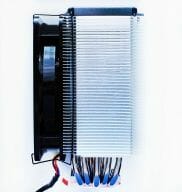
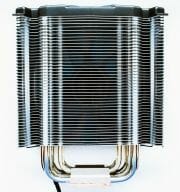
The heatsink is uni-directional, which means that the airflow needs to go in one direction for maximum cooling efficiency – namely towards the caved in side of the heatsink:
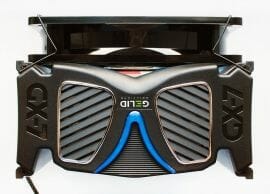

Everything seems to be pretty standard: only one tower, not gigantic size, one fan. So, what’s so special about GELID GX-7 to justify its 70-dollar price and high efficiency expectations?
Well, the secret is in the heatpipes. First of all, there are seven of them and they are arranged in two rows in the base: five heatpipes in the lower-level row and two heatpipes in the upper-level one:
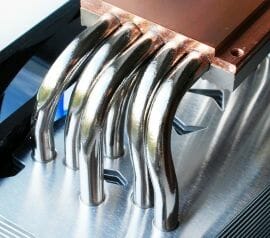

This heatpipes layout, according to GELID, ensures faster and more efficient heat transfer from the CPU hear-spreader. This is what it looks like schematically:
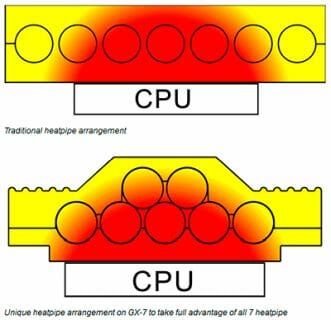
As we see, the two upper-level heatpipes are designed to help the thermally overloaded low-level heatpipes and schematically everything looks perfect. But will it actually work? Do not forget that it will be a bit of a challenge to push the airflow through the heatsink body with this heatpipe paling…
The base surface in GELID GX-7 is not ideally finished – we don’t see any polishing on it:
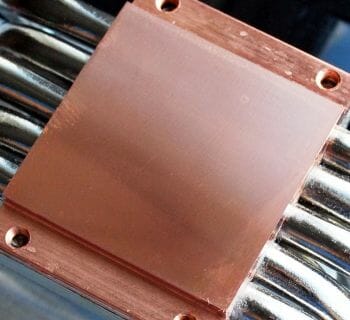
At the same time the 35×34 mm plate is impeccably even, the thermal paste imprints turned out complete and the paste got almost evenly distributed over the surfaces:
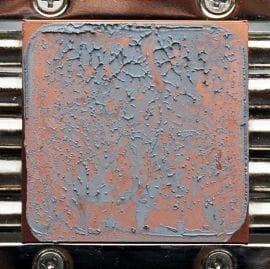
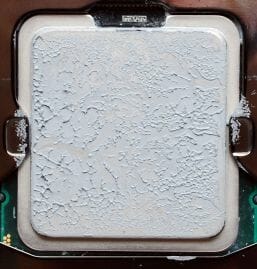
GELID GX-7 is equipped with one nine-blade GELID WING 12 PL fan (FN-FW12BPL-18) measuring 120x120x25 mm:
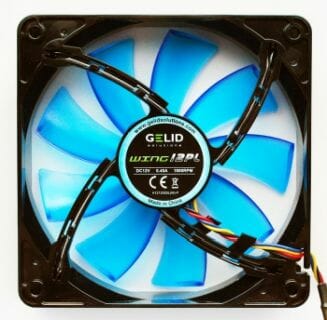
Its rotation speed is automatically adjusted using pulse-width modulation method (PWM) in the interval from 600 to 1800 RPM at a maximum airflow of 75.6 CFM and between 10 and 26.8 dBA of noise. The fan specifications also mention its static pressure of 2.66 mm H2O.
If you remove the rotor sticker, you will find Nanoflux Bearing (NFB) with at least 100,000 hours or more than 10 years declared MTBF:

Although the maximum fan power consumption is claimed to be 5.4 W, in reality GELID WING 12 PL consumed no more than 3.1 W. Its startup voltage was 4 V. By the way, this fan model is also available separately, so you can get one for… $22!
The fans are attached to the heatsink with two wire clips:

Another pair of clips like that is included with the bundled accessories, in case you decede to install a second fan for air exhaust.
Compatibility and Installation
GELID GX-7 is compatible with all contemporary platforms, though the sample we had at our disposal wasn’t yet modified to fit the new LGA 2011 socket. The installation procedure is described in detail in the following manual. The first step is to prepare the universal backplate, where you insert special threaded mounts:
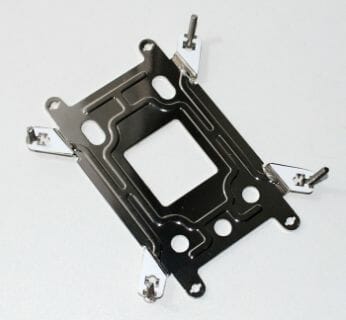
At the same time you need to attach steel retention brackets to the base of the cooler using included screws:
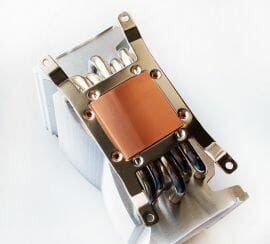
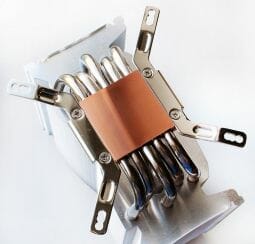
After that you apply a thin even layer of thermal paste to the CPU heat-spreader, install the cooler on top and tighten the screw-nuts with springs beneath them. This retention provides very high pressure hold and is highly reliable.
This retention mechanism allows GELID GX-7 to be installed in any position including the AMD platforms, where most cooling systems can often be installed only one way. GX-7 doesn’t have this restriction. During our tests on the LGA 1366 platforms the cooler’s efficiency didn’t depend on the position, in which it was installed on the CPU:
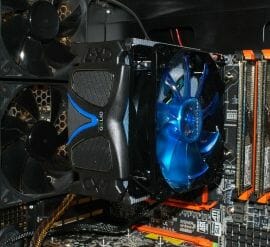
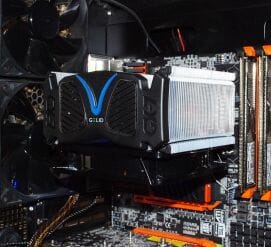
In both positions GELID GX-7 cooled the CPU the same way, and very soon we are going to find out how well. This is what GELID GX-7 looks like inside a system case with two cooling fans attached:
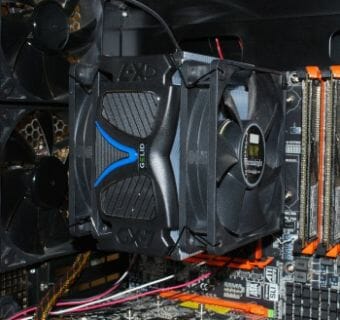
I would like to add that the distance from the lower heatsink fin to the mainboard surface is only 42 mm, and the fans hang another 4-5 mm below the heatsink, which may create some issues with tall heatsinks on the voltage regulator components around the processor socket. At the same time, this cooler doesn’t block the memory modules with tall heat-spreaders.
In conclusion I have to add that GELID GX-7 features beautiful blue LEDs:
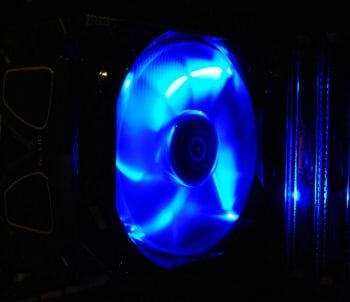
Technical Specifications and Recommended Pricing
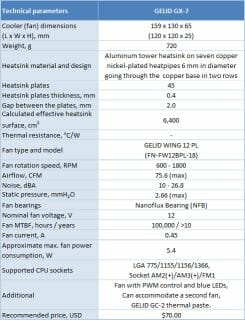
Testbed and Testing Methodology
We performed all cooler tests inside a closed system case. Here is our testbed configuration:
- Mainboard: Gigabyte GA-X58A-OC (Intel X58 Express, LGA 1366, BIOS F5c from 09/06/2011);
- Processor: Intel Core i7-980X Extreme Edition, 3.33 GHz, 1.225 V, 6 x 256 KB L2, 12 MB L3 (Gulftown, B1);
- Thermal interface: ARCTIC MX-4;
- Graphics card: ATI Radeon HD 5770 1 GB GDDR5 128 bit, 850/4800 MHz (with a passive heatsink from the DeepCool V4000 VGA cooler);
- Memory: DDR3 3 x 2 GB OCZ Platinum Low-Voltage Triple Channel (Spec: 1600MHz / 7-7-7-24 / 1.65 V);
- System drive: RAID-0 of 2 x Kingston V-series SNV425S2128GB SSD (SATA-II, 128 GB, MLC, Toshiba TC58NCF618G3T controller);
- Drive for programs and games: Western Digital VelociRaptor (300GB, SATA-II, 10000 RPM, 16MB cache, NCQ) inside Scythe Quiet Drive 3.5” HDD silencer and cooler;
- Backup drive: Samsung Ecogreen F4 HD204UI (SATA-II, 2 TB, 5400 RPM, 32 MB, NCQ);
- System case: Antec Twelve Hundred (front panel: three Noiseblocker NB-Multiframe S-Series MF12-S2 fans at 1020 RPM; back panel: two Noiseblocker NB-BlackSilent PRO PL-1 fans at 1020 RPM; top panel: standard 200 mm fan at 400 RPM);
- Control and monitoring panel: Zalman ZM-MFC2;
- Power supply: Xigmatek “No Rules Power” NRP-HC1501 1500 W (with a default 140 mm fan).
We overclocked our six-core processor (with its default non-lapped heat-spreader) with the multiplier set at 25x and “Load-Line Calibration” (Level 2) enabled to 4.3 GHz. The nominal processor Vcore was increased to 1.3875 V in the mainboard BIOS:
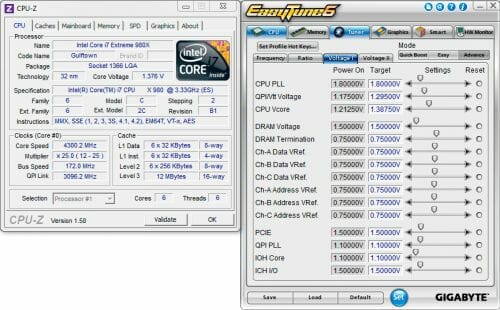
Turbo Boost and Hyper-Threading technologies were disabled during our test session. The memory voltage was at 1.5 V and its frequency was 1.38 GHz with 7-7-7-16_1T timings (Extreme profile). All other parameters available in the mainboard BIOS and related to CPU or memory overclocking remained unchanged.
All tests were performed under Windows 7 Ultimate x64 SP1 operating system. We used the following software during our test session:
- CPU Stress Test (CST) version 0.18b – to load the processor (matrix # 15, 10-12 minutes);
- Real Temp GT 3.64 – to monitor the processor core temperature;
- CPU-Tweaker 1.5 – to visually monitor temperatures and frequencies using graphics;
- Gigabyte Easy Tune 6 B11.0823.1 – to monitor voltages.
So, the complete screenshot during the test session looks as follows:
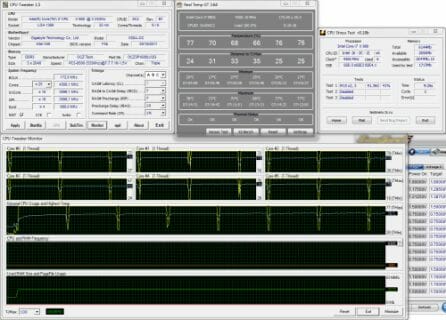
The CPU was loaded with two consecutive CST test runs with the settings as indicated above. The stabilization period for the CPU temperature between the two test cycles was about 8-10 minutes. We took the maximum temperature of the hottest CPU core for the results charts. Moreover, we will also provide a table with the temperature readings for all cores including their average values. The ambient temperature was checked next to the system case with an electronic thermometer with 0.1 °C precision that allows hourly monitoring of the temperature changes over the past 6 hours. The room temperature during our test session varied between 20.0-20.4 °C.
The noise level of each cooler was measured between 1:00 and 3:00 AM in a closed room about 20 m2 big using CENTER-321 electronic noise meter. The noise level for each cooler was tested outside the system case when the only noise sources in the lab were the cooler and its fan. The noise meter was installed on a tripod and was always at a 150 mm distance from the cooler fan rotor. The tested cooling systems were placed at the edge of the desk on a sheet of polyurethane foam. The lowest noise reading our noise meter device can register is 29.8 dBA and the subjectively comfortable noise level in these testing conditions was around 36 dBA (do not mix it up with low noise level). The fan(s) rotation speed was adjusted in the entire supported range using our in-house controller by changing the voltage with 0.5 V increment.
We are going to compare GELID GX-7 against Thermalright True Spirit ($30) tested with one default fan and two Thermalright TR-FDB fans. GX-7 was also tested with these two fans besides its default GELID WING 12 PL fan. We are going to use the results of Thermalright Archon tested with one and two Thermalright TY-140 fans as our reference point.
Now let’s check out the obtained results.
Cooling Efficiency Tests
The results of our cooling efficiency tests are summed up in the diagram and table below:
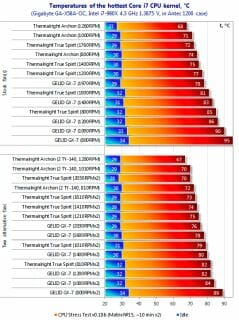
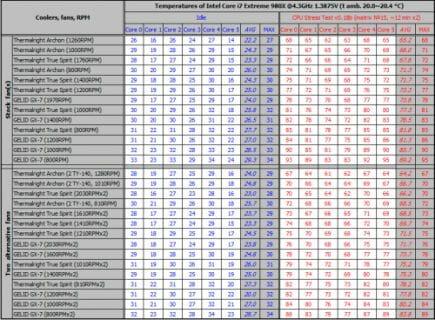
I have to say that the results of our cooling efficiency tests are not very encouraging. Almost in all speed modes of its default fan the new cooler loses 10°C to the Thermalright True Spirit selling for half the GELID’s price. The comparison with Archon, which price is closer to that of GELID GX-7, is completely pointless. The only thing we can point out in its defense is that its cooling efficiency depends a lot on the fan rotation speed, which we suspected would be the case earlier in our review. When the fan rotation speed increases from 800 to 1970 RPM, the maximum temperature of the hottest processor core drops by 17°C, while with Thermalright True Spirit when the fan rotation speed increases in a slightly narrower interval, from 800 to 1760 RPM, the temperature drops only by 13°C.
GELID GX-7 with two fans performs better, but still not good enough to outdo Thermalright True Spirit, which lowest advantage in peak temperature over GX-7 is 5-6°C. As for the comparison against Archon, the new GELID cooler will have to tame its ambitions here, too. GELID GX-7 with two roaring fans at 2030 RPM lost 4°C to Thermalright’s super-cooler with two fans at quiet 810 RPM. This is a definite fiasco.
During the maximum CPU overclocking tests of GELID GX-7 we discovered that the cooler equipped with one GELID WING 12 PL fan at its maximum speed of 1970 RPM can cope with a six-core processor overclocked to 4400 MHz at 1.43125 V Vcore and the peak temperature of the hottest core at 91°C:
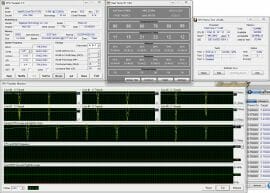
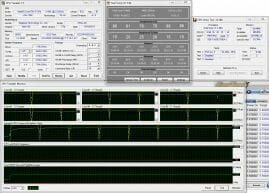
When we install two Thermalright TR-FDB fans onto GELID GX-7 cooler, even at their maximum speed of 2040 RPM we couldn’t increase the CPU frequency any higher, even though the peak processor core temperature dropped by 4 degrees.
Now let’s take a look at the results shows by GELID GX-7 at maximum speed of its default fan compared with all the previously tested coolers:
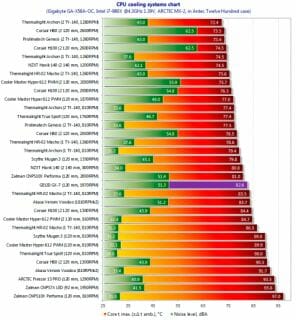
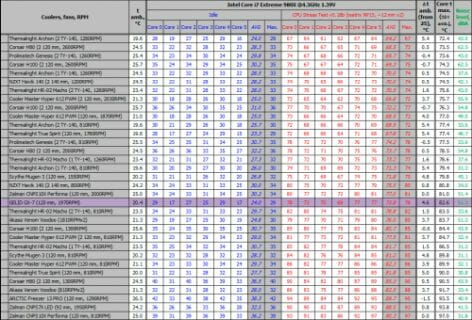
GELID GX-7 is in the middle of our “tournament table” and diagram, right between Zalman CNPS10X Performa at maximum 2000 RPM speed of its single default fan and Thermalright HR-02 Macho with two TY-140 fans at quiet 810 RPM. The results is quite average.
Now let’s check out the table and diagram with maximum CPU overclocking results for all tested cooling solutions. Besides the processor frequency, it also shows maximum temperature (taking into account the difference in the ambient temperature) and the level of generated noise:
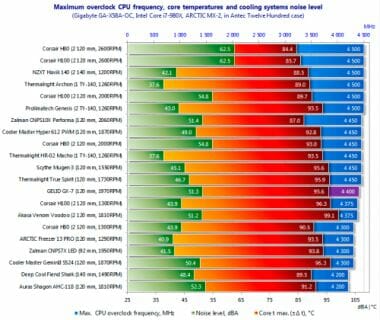
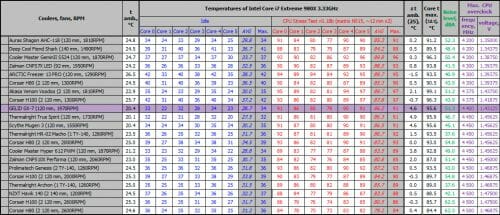
GELID GX-7 is again almost in the very middle of the pack. This results obviously doesn’t match the price of the cooler.
Acoustic Performance
We measured the acoustic performance of our today’s testing participants in the entire rotation speed range of their fans. The results are summed up on the following graph:


Well, at least GELID GX-7 did well in the noise test and achieved the same results as Thermalright True Spirit and Archon (without taking into consideration the maximum rotation speeds of their fans). GELID WING 12 PL fan turned out really well-built and of superb quality. It doesn’t crackle or howl in entire rotation speed range, has low startup voltage of 4 V and relatively low power consumption (3.1 W). The impeller is very well-balanced, which excludes the possibility of beating and should ensure long life span. Besides, it can be removed, which makes it easy to care for it.
Conclusion
GELID GX-7 didn’t prove up to our expectations and turned out just another cooler, which price is obviously set too high. If the second row of heatpipes does work, then the heatsink must be not efficient enough, because of its small surface size and high dependence on the fan rotation speed. GX-7 could have probably been more appealing, if it were provided with two WING 12 PL fans instead of one and GC-EXTREME thermal paste. But in its current configuration it should be priced at no more than $50-$55, because the competition in this segment is currently so serious that it will be difficult to get through even for more attractive coolers, like Scythe Mugen 3, for instance.
So, what could be a potential selling point for the new GELID GX-7? I believe it is its universal design, relatively simple installation procedure, reliable retention, low noise at up to 1100 RPM and attractive LED highlighting of the fan. If you care a lot about all these features, you are satisfied with GX-7’s cooling efficiency and are ready to invest $70 in it, then the new GELID GX-7 will definitely find a way into your system one day.